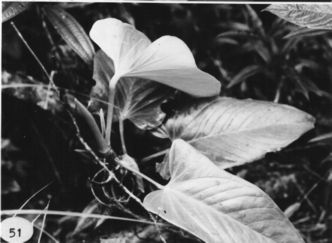



Anthurium cinereopetiolatum Croat, sp. nov.
TYPE: Panama. Panama: Cerro Jefe, 21 km above Pan-American Hwy., ca. 600 m, Croat 35868 (MO 2381198, holotype; NY, PMA, isotypes; Live at MO).
Planta epiphytica aut raro tenestris; cataphyllum 7- 20 cm longum, friabilis, cadens intactum; petiolus 6-30 cm longus, subrotundatus; lamina anguste lanceolata-triangularis, basi lobatus, 20-55 cm longa. 6-20 cm lata. Inflorescentia effusa aut pendens, foliis breviora; pedunculus 12.5-25 cm longus, teres: spatha viridis pallide, interdum purpureo tincta, 6-14 cm longa, 1.6-2.5 cm lata, basi amplectens; spadix sessilis. viridis, 6-15 cm longus, basi 6-9 mm diam., apice 3-6 mm diam. Baccae ovoidae, purpurea, apice acuiae.
Epiphytic or rarely terrestrial; stems elongate, to 20 cm or more, 1.5-2.5 cm diam.; gray-green: internodes 1÷6 cm long, shorter near the stem apex; leaf scars 1-2 cm wide; roots several at some nodes, thick, branching; cataphylls medium thick, brittle, 7-20 cm long, acuminate at apex, with a subapical apiculum, drying tan. remaining intact and deciduous after drying.
LEAVES erect-spreading to subpendent; petioles 6-30 cm long, 5-7 mm diam., flattened laterally, shallowly and sharply sulcate adaxially, rounded abaxially; geniculum 1.9-2.5 cm long, sometimes purplish, shaped like petiole; blades narrowly lanceolate-triangular, subcoriaceous, acute to gradually acuminate at apex, lobed at base. 20-55 cm long, 6-20 cm wide, broadest at base: anterior lobe 19-45 cm long, posterior lobes 1.5÷ 12 cm long, directed outward and slightly upward, the sinus parabolic to triangular, rounded at apex; upper surface semiglossy; lower surface matte, obscurely punctate; midrib raised above. diminishing and sunken at apex, raised below. basal veins 4-6 pairs, the second to fourth coalesced 0.5-1 cm, sunken above, raised or flat below; posterior rib naked, the outer margin slightly upturned; primary lateral veins 9-30 per side, departing midrib at 45-60¡ angle, weakly raised in valleys above, flat below; collective vein arising from uppermost or second pair of basal veins, about as prominent as major lateral veins. 3-8 mm from the margin, sunken above, flat or slightly raised below.
INFLORESCENCE erect-spreading, shorter than the leaves; peduncle 12.5-25 cm long, 5-7 mm diam.; terete, as long as to longer than petioles; spathe medium thick, pale green sometimes tinged purplish, narrowly lanceolate, 6-14 cm long, 1.6-2.5 cm wide, broadest at base, acuminate al apex, obtuse to clasping at base, inserted at 30-45¡ angle on peduncle: spadix sessile, green, 6-15 cm long, 6-9 mm diam. at base, 3-6 mm diam. at apex; flowers 4-lobed. 2-3.1 mm long, 2.3-2.9 mm wide, the sidesjag-gedly sigmoid, 4-10 flowers visible in the principal spiral, 7-12 flowers visible in the alternate spiral; tepals glossy, with droplets scattered throughout before stamens emerge, the lateral tepals 1.2-1.6 mm wide, the inner margin straight to slightly convex; pistil not emergent before an-thesis, pale green, very glossy; stigma ca. 0.3 mm long, linear, slightly indented; stamens emerging from base more or less rapidly, held in cluster over pistil when complete; anthers white, ca. 0.5 mm long, 0.8 mm wide, thecae ellipsoid, slightly divaricate; pollen white.
INFRUCTESCENCE pendent, spathe green, reflexed, sometimes deciduous; spadix 12-31 cm long, ca. 2 cm diam.; berries pale red-violet to red, ovoid to oblong, pointed to narrowly rounded at apex, 6-9 mm long, 4-5 mm diam.; pericarp thin, with moderately conspicuous raphide cells; seeds 2, greenish white (?), flattened, more or less ellipsoidal, 2.5-3 mm long, 2-2.2 mm wide, 1-1.5 mm thick, enveloped completely in an ellipsoidal or ob-ovoid gelatinous, transparent substance, 4÷4.5 mm long. Fig. 51.
Anthurium cinereopetiolatum is known definitely only from central Panama east of the isthmus, where it inhabits tropical wet and premontane rain forest life zones at 600 to 1,000 m. A collection from Colombia, Department of Choco (Killip 35253), is possibly this species, but the collection is sterile.
Sectional placement of Anthurium cinereopetiolatum is uncertain and it is tentatively placed in section Belolonchium. This species is closest to A. hebetatum, which has a similar thick, persistent cataphyll, a slender, more or less elongated stem, coriaceous leaf blades, a greenish spadix and spathe, and reddish berries. Both species also have grayish cataphylls and petioles (hence the name cinereopetiolatum). Anthurium cinereopetiolatum differs from A. hebetatum, however, in having a narrowly triangular or ovate-triangular blade (broadest at the base) with the posterior lobes sometimes turned weakly outward. The blades of A. hebetatum are almost oblong and usually broadest well above the base. The posterior lobes are poorly developed or lacking. In addition, the upper blade surface of A. cinereopetiolatum is semiglossy, whereas in A. hebetatum the blade surface is matte.
 |
Panama: vicinity Cerro Jefe, Almeda & Nakai 3448 (CAS), Correa 563 (MO), Croat 35868 (MO, NY, PMA), 49089 (MO), Folsom & Page 5933 (MO), Gentry ft al. 3502, 3503 (MO), Mori et al. 3780 (MO), Plowman & Weil 3155 (K); NE of Altos de Pacora, Croat 22726 (F, MO, PMA), Mori & Kallunki 6053 (MO).